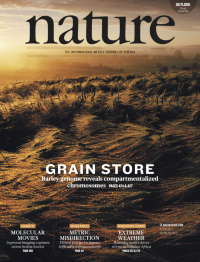Volume 544
-
No. 7651 27 April 2017
Domesticated some 10,000 years ago, barley has been a key crop since the dawn of agriculture. In this weekâs issue, Nils Stein and colleagues in the International Barley Sequencing Consortium report the sequencing and assembly of a reference genome for this important grain. They produced the genome for Hordeum vulgare L. by combining hierarchical shotgun sequencing of bacterial artificial chromosomes, genome mapping on nanochannel arrays and chromosome-scale scaffolding with conformation capture sequencing. The result is the first comprehensive, completely ordered assembly of the pericentromeric regions of a Triticeae genome â and it reveals that each of barleyâs seven chromosomes is divided into three compartments. The authors also sequenced and examined genetic diversity in the exomes of 96 European elite barley lines with a spring or winter growth habit, highlighting the potential utility of the sequence for cereal genomics and breeding programmes.
-
No. 7650 20 April 2017
The cover shows an artistâs impression of the repeated production of flexible films by remote epitaxy. Although epitaxy is widely used in the semiconductor industry, cost still restricts the technique to only certain materials. In this issue, Jeehwan Kim and his team suggest a possible way to overcome that limitation. They place a monolayer of graphene between the substrate and the âepilayerâ grown on top. The graphene layer does not interfere with epitaxial growth but, crucially, it allows the film produced to be released from the substrate easily, thereby allowing the substrate to be reused. The ability to âcopy and pasteâ semiconductor films from underlying substrates and transfer them to a substrate of interest could have implications for heterointegration in photonics and flexible electronics. Cover image: Felice C. Frankel (with artwork by Nik Spencer).
-
No. 7649 13 April 2017
Macroscopic patterns in the animal world, such as zebra stripes and leopard spots, can be described by processes occurring at the scale of biological cells. In this issue, Michel C. Milinkovitchâs team reveals a dynamical process that coordinates pattern formation on the skin of ocellated lizards. By recording the shifting patterns over four years, the team found that the colour changes occur at the level of individual skin scales and obey the rules of a hexagonal cellular automaton â a grid of elements whose states change according to the states of neighbouring elements. Numerical simulations and mathematical derivation show that such a discrete system can emerge at the mesoscopic scale from the continuous reactionâdiffusion framework when variations in skin thickness are taken into account. The teamâs work suggests that cellular automata are not just abstract computational systems, but that they can directly correspond to processes generated by biological evolution. Cover image: Michel C. Milinkovitch.
-
No. 7648 6 April 2017
The swirling lines in the cover image reveal the instantaneous direction of air flow induced by a mosquitos flapping wings. Richard Bomphrey and his colleagues show that the remarkably high wingbeat frequencies and shallow stroke amplitudes used by mosquitoes lead to novel aerodynamic mechanisms. Like most insects, the mosquito generates lift from leading-edge vortices, but this is augmented by trailing-edge vortices, which capture energy left over from previous wingbeats. This exquisitely timed rotational mechanism may explain the unusually high aspect ratio of mosquito wings, as it allows the insect to maximize the aerodynamic force along their wingspan. Cover image: Toshiyuki Nakata.




